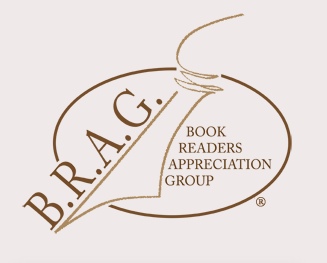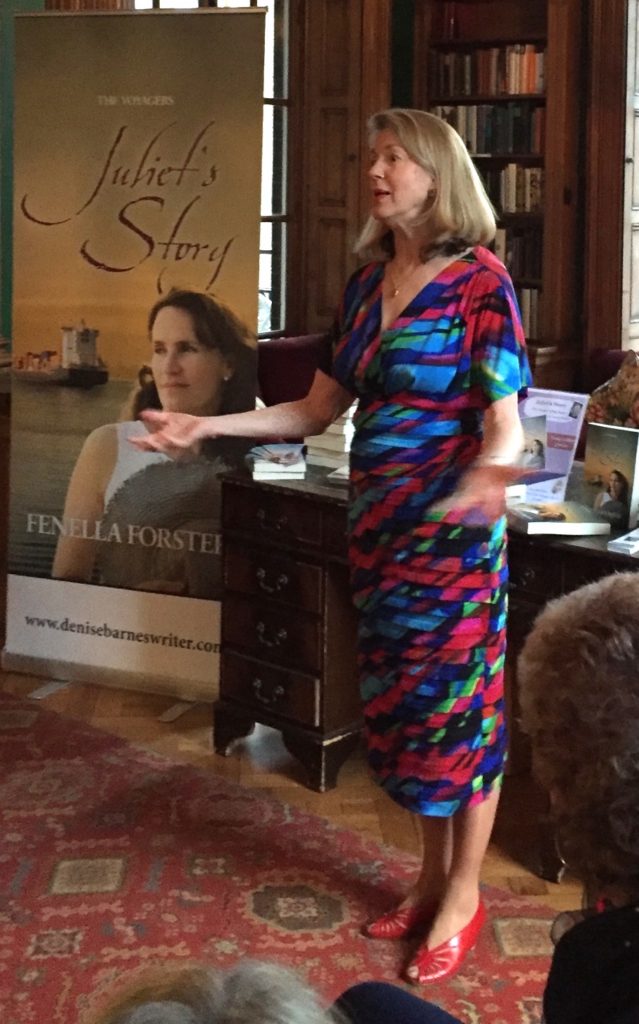 Today is the start of a new, possibly disruptive series, ‘Love me, love my character’. I’m inviting authors and their characters to give us their separate views. Hopefully, we may get some unexpected results. Today is the start of a new, possibly disruptive series, ‘Love me, love my character’. I’m inviting authors and their characters to give us their separate views. Hopefully, we may get some unexpected results.
Fenella Forster (the writing name of Denise Barnes) writes sagas with a difference: all involve ‘voyages’, physical as well as emotional ones. Her heroines live in the early 20th century, the recent past and the Second World War; we travel from Norfolk to Australia, London, Cairo, Italy and across three generations to discover deep family secrets, some shocking. Annie’s Story and Juliet’s Story are published through SilverWood Books and Kitty’s Story is in the works.
Thanks, Alison, for inviting me on to your blog to talk about Juliet’s Story. It’s great to be here.
Why did you write this book?
It was a natural progression to Annie’s Story, which is Book 1 of The Voyagers trilogy. Although the first book is a historical saga set in 1913, Juliet’s Story, Book 2 in the trilogy, is a present-day heroine who is Annie’s granddaughter. I wrote them together in a dual timeline story to begin with as they both sail to Australia, though Juliet has very different reasons from her grandmother, but was advised by a couple of agents that it was too long and to split them into two separate novels. I was really upset at the time, but am so pleased with the result as both women now have their own far richer stories to tell.
Why do you think Juliet is like she is?
Juliet is an intelligent and attractive woman of 47. She’s recently divorced and brilliantly runs her own business selling other people’s businesses, but she doesn’t have much success in running her own life. She’s full of insecurities and feels a failure where men are concerned and not a little cynical. So when she’s confronted by the gorgeous Jack on the freighter to Australia she’s confused by her strong feelings of sexual attraction. In her nervousness she is unjustifiably acerbic with him. Most of these insecurities stem from her background and the secret she holds close in her heart. She goes to pieces more than once, big time, but on the whole she thinks she handles things pretty well. We know she doesn’t. She’s quite selfish and opinionated, yet she’s generous and would be demonstrative and loving if only she could stop being so cynical.
What does Juliet think she is like?
‘I’ve made a balls-up about a lot of things in my life but I try hard not to let it make me bitter. My parents encouraged me into a marriage where it was obvious to anyone I never loved him. I was trying to please them and let myself be talked into it because I thought Gerrard would help me get over my terrible mistake when I was a teenager. Then I found I couldn’t talk to him about it because he was always so judgemental. I just felt I needed to escape my problems and that’s why I couldn’t wait to leave the business and sail off to Australia. But I wasn’t prepared to meet someone like Jack. I became tongue-tied like some silly love-struck teenager. And every time we got a bit close I’d spoil things and say something hurtful. I hated myself but I couldn’t stop it. But I was terrified of falling in love with him and he was just using me for a shipboard romance. So I had to pretend I didn’t care.
But in the end it was the voyage which began to change me, and I’m sure for the better. I think I became more compassionate because so many people on the ship, and in Australia, showed me great kindness. It’s made me realise how lucky I am. And maybe – just maybe – I am loveable enough to be loved.’
(Well said, Juliet!)
Back to Denise…Thanks, Alison, for having me. It was fun talking about Juliet, and I must say I was quite surprised with what she came out with about herself. She knows her own shortcomings more than I’d realised!
Thank you, Fenella (and Juliet) for stopping by.
So what’s Juliet’s Story about?
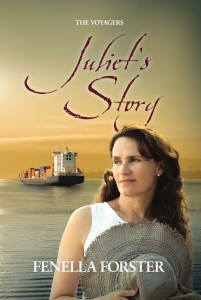 Can secrets destroy love? Can secrets destroy love?
It’s 2005. Whatever the risk, businesswoman Juliet Reece grabs a once-in-a-lifetime opportunity with both hands.
She’s been given the freedom and time to sail to Australia to trace her emigrant grandparents’ story back in 1913. But buried under the surface is a more compelling reason – a secret she has held close since she was a vulnerable sixteen- year-old, which only her grandmother, Annie, shared – and whose answer may lie in Australia.
When Juliet boards the Alexandria at Tilbury she doesn’t count on meeting the enigmatic Jack Delaney. But is it wise to fall for a man from the other side of the world who seems to be carrying dark secrets of his own?
Available as a paperback from good bookshops and online retailers, and as an ebook from Amazon, Kobo iBooks, Nook; all links here.

Connect with Denise via Twitter, Facebook and her blogsite.
STOP PRESS! I’ve just heard that Denise has been snapped up by the hhb literary agency who will be representing her for all her work.
Congratulations, Denise/Fenella!
Alison Morton is the author of Roma Nova thrillers, INCEPTIO,
PERFIDITAS, SUCCESSIO and AURELIA. The fifth in the series, INSURRECTIO, was published in April 2016.
Find out more about Roma Nova, its origins, stories and heroines…
If you enjoyed this post, do share it with your friends!Like this:Like Loading...
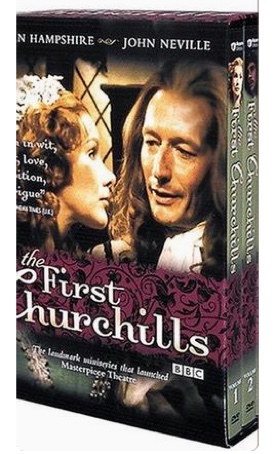 I’d never been to Blenheim, or Blenheim Palace as it’s more properly called. I knew it was the home of John and Sarah Churchill, the first (gifted and ambitious) Duke and Duchess of Marlborough, by having watched The First Churchills, an excellent BBC series made in 1969. I’d never been to Blenheim, or Blenheim Palace as it’s more properly called. I knew it was the home of John and Sarah Churchill, the first (gifted and ambitious) Duke and Duchess of Marlborough, by having watched The First Churchills, an excellent BBC series made in 1969.
Built built between 1705 and circa 1722 in the English Baroque style, it’s the only palace that wasn’t a royal or episcopal one, a gift (mostly) from a grateful nation for Marlborough’s military triumphs against the French and Bavarians during the War of the Spanish Succession, culminating in the 1704 Battle of Blenheim.
However (there’s always a ‘however’), soon after its construction began, the palace became the subject of political infighting which led to Marlborough’s exile, the fall from power and influence of his duchess and lasting damage to the reputation of the architect Sir John Vanbrugh.
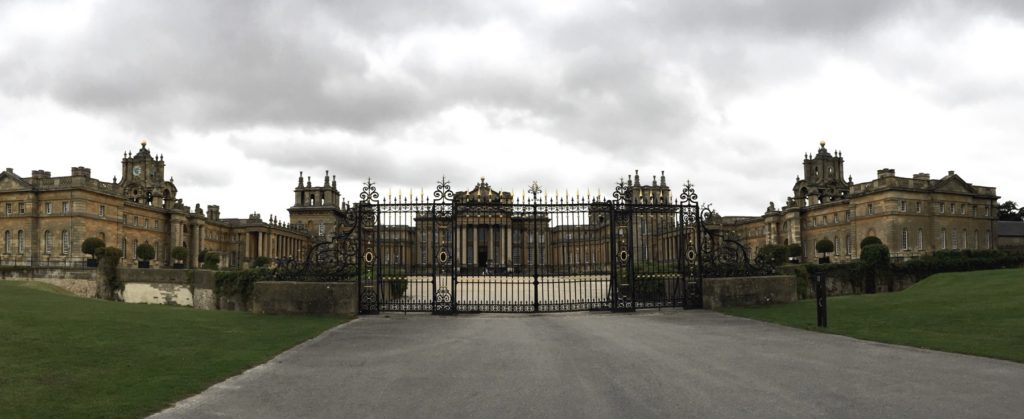 The Great Court  Consuelo Vanderbilt by Paul César Helleu At the end of the 19th century, the palace was saved from ruin by funds gained from the 9th Duke of Marlborough’s marriage to American railroad heiress Consuelo Vanderbilt. Her mother, Alva Vanderbilt, was desperate to see her daughter a duchess, and the bride’s father, William Vanderbilt, paid for the privilege. The final price was $2,500,000 (worth over $70 million today) but it wasn’t a very happy marriage; and they separated and both remarried. The other famous fact is that Winston Churchill was born at Blenheim and retained close links all his life with his cousins there.
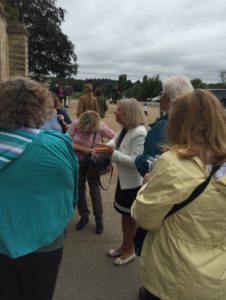 Isobel, giving us some background When one of my colleagues on the a fellow member of the Historical Novel Society organising committee asked for a volunteer to accompany the group making the excursion there, I leapt at it. Although cloudy,it didn’t actually rain. We had a friendly and knowledgeable guide, Isobel, from Explore Oxford Tours, plus an indoor guide, the softly spoken William.
Although a ‘national monument’ and UNESCO World Heritage Site the palace remains the home of the Dukes of Marlborough. The palace, park, and gardens are open to the public and include a maze, adventure playground, mini-train, gift shops, butterfly house, fishing, cafeteria and bottled Blenheim Natural Mineral Water. Game, farming and property rentals, along with concerts, filming and festivals in the palace and park help keep the palace financially afloat.
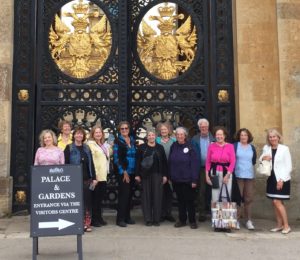 Our happy band Our jolly group enjoyed the house tour and then explored part of the grounds by buggy, taking the obligatory photos, plus a few anarchic ones, ate in the cafeteria in the basement (very tastefully decorated, but we knew our place) and strengthened ourselves by some retail therapy.
So what did we see?
(My anarchic selection!)
 Eye-eye! The second wife of the 9th duke had their eyes painted under the main portico  Pespective
 Beautiful ceiling, library 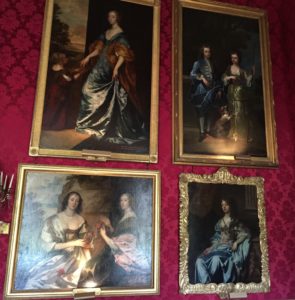 Churchill and Spencer ladies
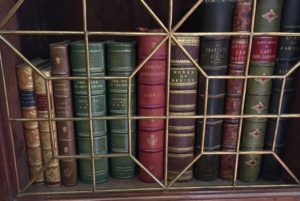 Interesting selection on one shelf (Click to see what I mean.)
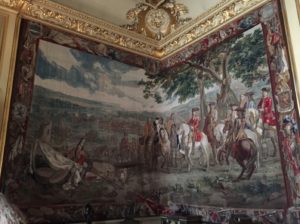 Tapestry of Marlborough accepting the French surrender after the Battle of Blindheim 1704 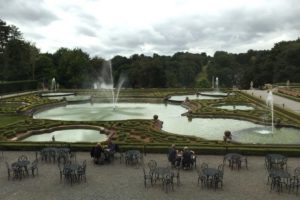 Water terraces
 Gilded decoration  The classic view  Sheep, geese and Victory  One side of the Great Court
 Retail therapy results
Update 2022: Alison Morton is the author of Roma Nova thrillers – INCEPTIO, CARINA (novella), PERFIDITAS, SUCCESSIO, AURELIA, NEXUS (novella), INSURRECTIO and RETALIO, and ROMA NOVA EXTRA, a collection of short stories. Audiobooks are available for four of the series.Double Identity, a contemporary conspiracy, starts a new series of thrillers. JULIA PRIMA, a new Roma Nova story set in the late 4th century, is now out.
Find out more about Roma Nova, its origins, stories and heroines and taste world the latest contemporary thriller Double Identity… Download ‘Welcome to Alison Morton’s Thriller Worlds’, a FREE eBook, as a thank you gift when you sign up to Alison’s monthly email update. You’ll also be among the first to know about news and book progress before everybody else, and take part in giveaways.
If you enjoyed this post, do share it with your friends!Like this:Like Loading...
 Today I’m delighted to welcome to my blog somebody whose writing I deeply admire. I bought ‘The First Ladies of Rome’, which explored the hidden history of women in Ancient Rome, as soon as I saw it in 2010. The author and today’s honoured guest, Annelise Freisenbruch, was born in Bermuda and studied Classics at Newnham College, Cambridge, receiving her PhD in 2004. She currently lives in Dorset and is Head of Classics at Port Regis School. In 2010, her first book ‘The First Ladies of Rome’ (‘Caesars’ Wives’ in the US) was published to critical acclaim. Her first novel ‘Rivals of the Republic’ – the opening instalment of The Blood of Rome series – has just come out in the US and will appear in the UK on 20 Octoober. Today I’m delighted to welcome to my blog somebody whose writing I deeply admire. I bought ‘The First Ladies of Rome’, which explored the hidden history of women in Ancient Rome, as soon as I saw it in 2010. The author and today’s honoured guest, Annelise Freisenbruch, was born in Bermuda and studied Classics at Newnham College, Cambridge, receiving her PhD in 2004. She currently lives in Dorset and is Head of Classics at Port Regis School. In 2010, her first book ‘The First Ladies of Rome’ (‘Caesars’ Wives’ in the US) was published to critical acclaim. Her first novel ‘Rivals of the Republic’ – the opening instalment of The Blood of Rome series – has just come out in the US and will appear in the UK on 20 Octoober.
Salve Annelise!
Rivals of the Republic is described as a crime adventure set in the world of the late Roman Republic. It centres on the real-life character of Hortensia, a young woman who has inherited the gifts of her orator father Hortensius, Rome’s flamboyant ‘king of the law court’. Now, what attracted you to the story of Hortensia?
I first came across her name when I was researching the education of Roman women for my first (non-fiction) book, The First Ladies of Rome. We only really know two things about her as a historical figure. One, that she was the daughter of Hortensius Hortalus – Rome’s greatest orator and courtroom rival of Cicero – and two, that she once delivered a much-praised address in the middle of the Roman forum that contradicted traditional Roman thinking that women couldn’t – and shouldn’t – make public speeches (a sentiment, I might add, that still seems to linger in many quarters today).
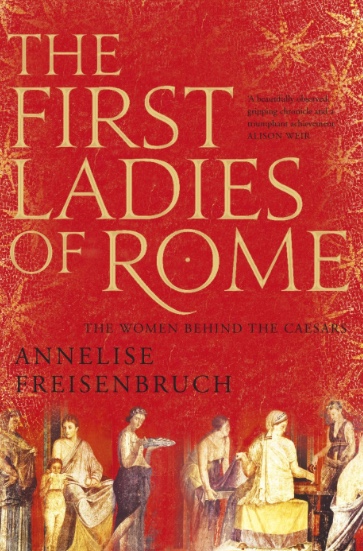 I hadn’t given much thought to writing a historical novel up to this point. But I couldn’t get Hortensia out of my head. Her famous speech was delivered during a very tense period in the late Roman Republic, just after the assassination of Julius Caesar. Hortensia was arguing passionately against a proposal that women like her should be taxed for pay for the wars of men. I started to think, where did it all begin for her? – was this the only speech she ever made? What if I create a fictional narrative for her, going back many years before, in which she tries to follow in the footsteps of her father, taking on cases, pursuing them to the law court if necessary, using her wits and intelligence to seek out injustice and corruption? By now I had a clear image of the character in my mind, and I just had to give her a voice. I hadn’t given much thought to writing a historical novel up to this point. But I couldn’t get Hortensia out of my head. Her famous speech was delivered during a very tense period in the late Roman Republic, just after the assassination of Julius Caesar. Hortensia was arguing passionately against a proposal that women like her should be taxed for pay for the wars of men. I started to think, where did it all begin for her? – was this the only speech she ever made? What if I create a fictional narrative for her, going back many years before, in which she tries to follow in the footsteps of her father, taking on cases, pursuing them to the law court if necessary, using her wits and intelligence to seek out injustice and corruption? By now I had a clear image of the character in my mind, and I just had to give her a voice.
We read a lot about the public and private spheres; our perception is that men occupied the public, military and political, i.e. ostensibly held the power, whereas (respectable) women were confined to the private, i.e. the home, children and domestic management, and lived under the tutelage of father, husband or brother. How true was this and did it change over Rome’s 1229 year long history?
Broadly speaking, this is a pretty accurate characterisation of the roles assigned to men and women in ancient Rome, no matter which point on the timeline you’re talking about. Rome was a man’s world, no two ways about it, and women were expected to stay out of the limelight, confining themselves, as you say, to the domestic sphere.
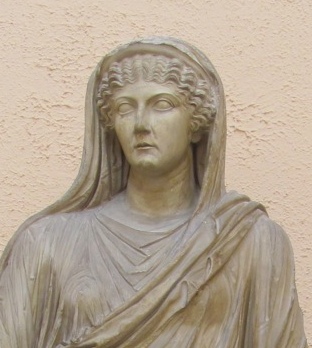 Livia Drusilla But we can finesse the picture a little. A very small number of women from the elite political class began to receive public honours and accolades during the Republican period (509BC-27BC) and during the age of emperors (27BC-AD 476) as my first book explores, we see empresses like Livia, Agrippina, Julia Domna and Galla Placidia making the kind of incursions into the public sphere that would have been unthinkable before – becoming highly visible figures in the public pageantry of their sons and husband’s reigns and, according to some sources, exercising extraordinary influence over them.
Even so, we must be careful before we start indulging in fantasies about these women being the real power behind the throne. For a woman to stray too far out of the domestic and into the public sphere – in other words to act too much the man – was a very dangerous game in the Roman world. This, in fact, is part of what makes Hortensia’s story so intriguing. Although her speech was much praised by male Roman writers, it’s made clear the excellence of her oratory is a tribute to the fact that she’s inherited the gift from her father. When my Hortensia ventures into the male-dominated world of the Roman law court and at the same time begins investigating a series of murders that appear to lead to a conspiracy at the heart of Roman politics, her reputation as well as her life is at stake – she is going somewhere women are not supposed to go.
What are the chief obstacles and pleasures of researching and writing women in Republican Rome, a period which ran from 509-27 BC?
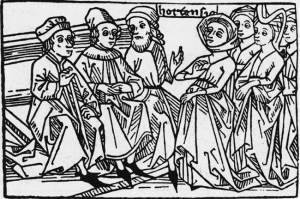 Medieval depiction of Hortensia Sometimes, I look wistfully at the kind of sources historians from later eras have and think, what wouldn’t I give for a diary or a letter written by a Roman woman in her own hand. The biggest obstacle in researching Roman women is the simple fact that virtually no writing by a woman from the period survives. Even Hortensia’s speech only survives second-hand. Did she write it all herself? Is it a verbatim account of what she said? We just don’t know. We are always limited to seeing Roman women through the eyes of others, usually men who never met them and who are often writing about them decades or even centuries after their deaths.
Conversely, that means that the fragments and clues we DO have are all the more precious and fascinating. There are wonderful, surprising examples of evidence for Roman women’s lives that were certainly helpful to me in writing Rivals of the Republic. To give just one example, I did some research into real-life Roman court cases involving women and came across a divorce case from 100 BC where a man tried – and failed – to keep his wife’s dowry on the grounds that she had been unfaithful during their marriage. I used that case as the inspiration for the trial scene in which Hortensia makes her court room debut.
But for me the greatest joy of writing historical fiction as opposed to non-fiction has been the freedom it’s given me, not just to make good use of the evidence for women’s lives that we do have, but to fill in the gaps around it and paint a full colour portrait of a flesh and blood woman and the world she inhabited. Hortensia feels very real to me now, and I’m hoping that people will love her as much as I do.
Thank you so much, Annelise. (I certainly enjoyed my advance copy of Rivals of the Republic and will be posting a review.)
Connect with Annelise:
Twitter: @afreisenbruch
Website: www.annelisefreisenbruch.co.uk
Rivals of the Republic (hardback) is available now on Amazon.com and for pre-order on Amazon UK.
So what’s Rivals of the Republic about?
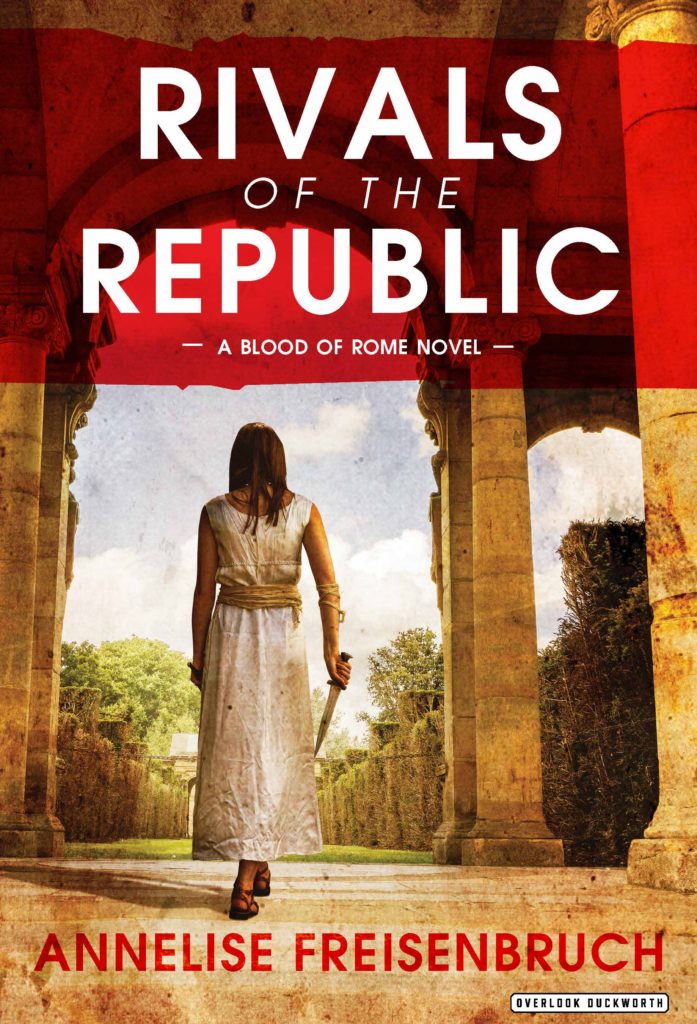 The body of a Vestal Virgin is dragged out of the River Tiber. A senator bleeds to death in his bath. Rome has just survived a period of bloody civil war, and while politics seem steady on the surface, discontent is rising as new alliances—and enemies—are formed. The body of a Vestal Virgin is dragged out of the River Tiber. A senator bleeds to death in his bath. Rome has just survived a period of bloody civil war, and while politics seem steady on the surface, discontent is rising as new alliances—and enemies—are formed.
As the authorities turn a blind eye, Hortensia, daughter of the capital’s most celebrated orator, feels compelled to investigate a trail of murders that lead to the dark heart of Rome. Flying in the face of her husband’s and father’s attempts to protect her, rebelling against the constraints imposed upon her sex, she is drawn ever deeper into the corrupt underworld that lurks in the shadows cast by the city’s all-powerful elite.
As Hortensia races to uncover and obstruct a plot to overthrow the Roman Republic, only one man can save Hortensia from becoming the next victim of a conspiracy to destroy the Republic: Lucrio, the damaged ex-gladiator to whom she already owes her life. But will the secrets of his own tragic past threaten to subsume them both…
UPDATE: Read Annelise’s article “7 surprising facts about Roman women” at BBC History Extra.
Alison Morton is the author of Roma Nova thrillers, INCEPTIO, PERFIDITAS, SUCCESSIO and AURELIA. The fifth in the series, INSURRECTIO, was published in April 2016.
Find out more about Roma Nova, its origins, stories and heroines…
If you enjoyed this post, do share it with your friends!Like this:Like Loading...
I’ve been away at the Historical Novel Society Conference where I was coordinating the indie table, helping with registration and problem solving, plus running a panel on indie publishing. There will be a report – I promise – but in the meantime, here are some photos…
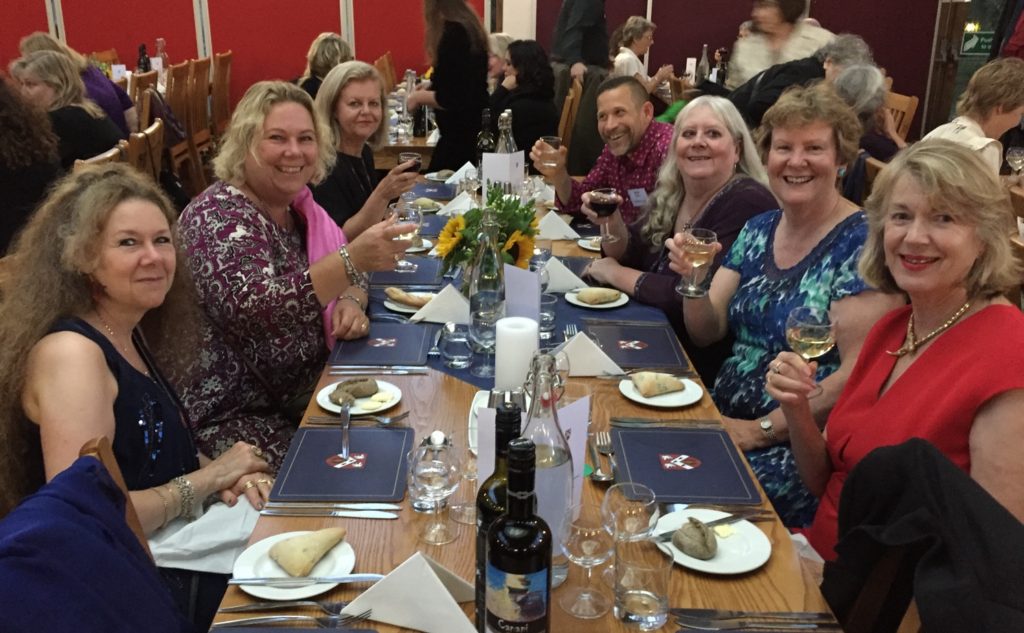 HNS16 gala dinner. Left to right: Christina Courtenay, Anna Belfrage, Liz Cooper, Christoph Fischer, Helen Hollick, moi, Denise Barnes
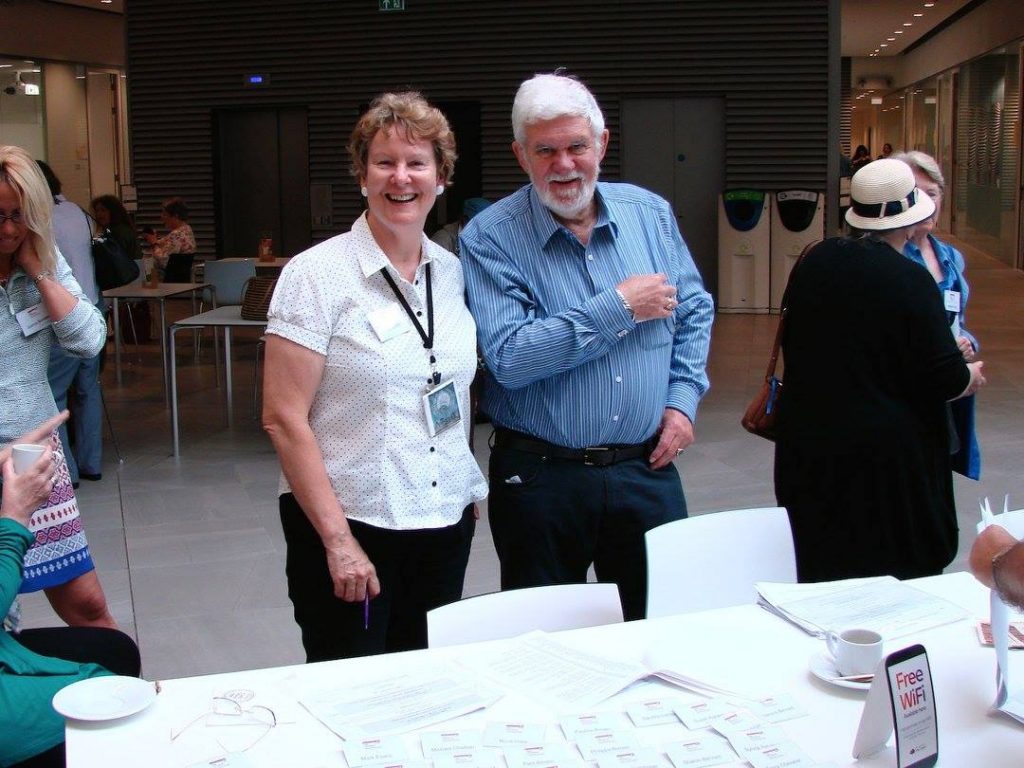 With Antoine Vanner, ‘The Master’, who led the front of house team
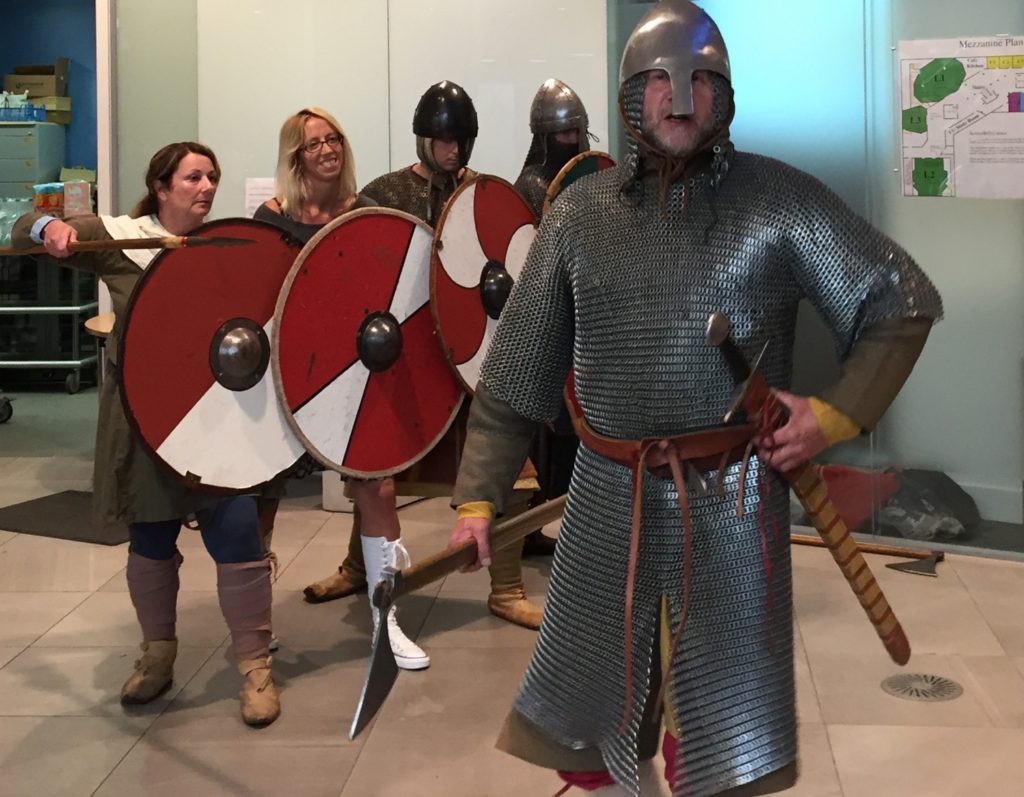 The Saxon shieldwall
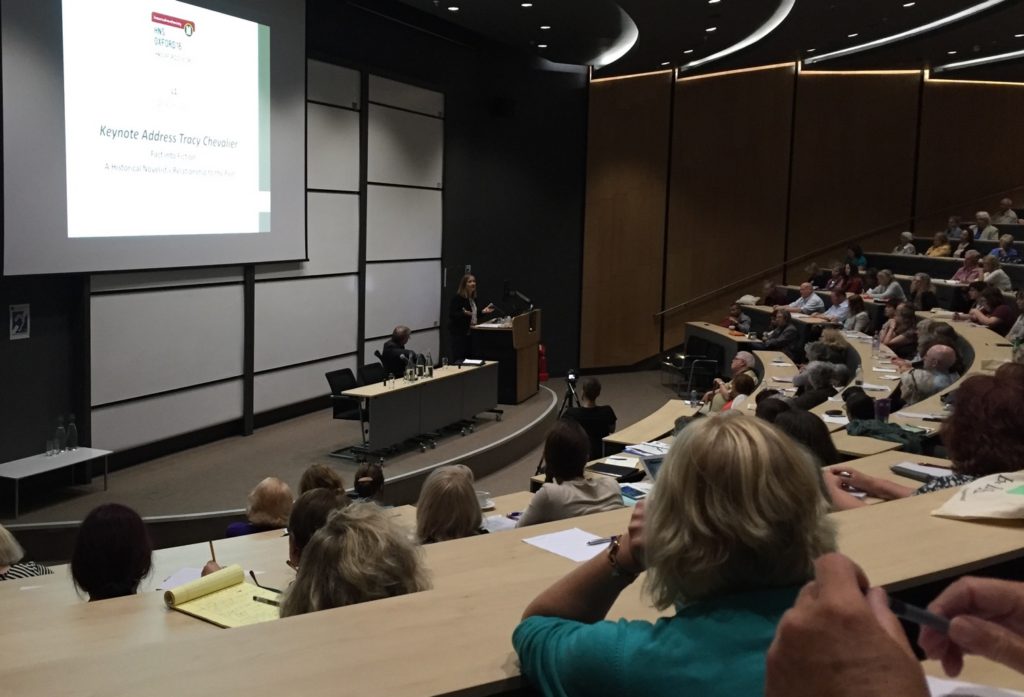 The lecture theatre with (a tiny) Tracy Chevalier speaking
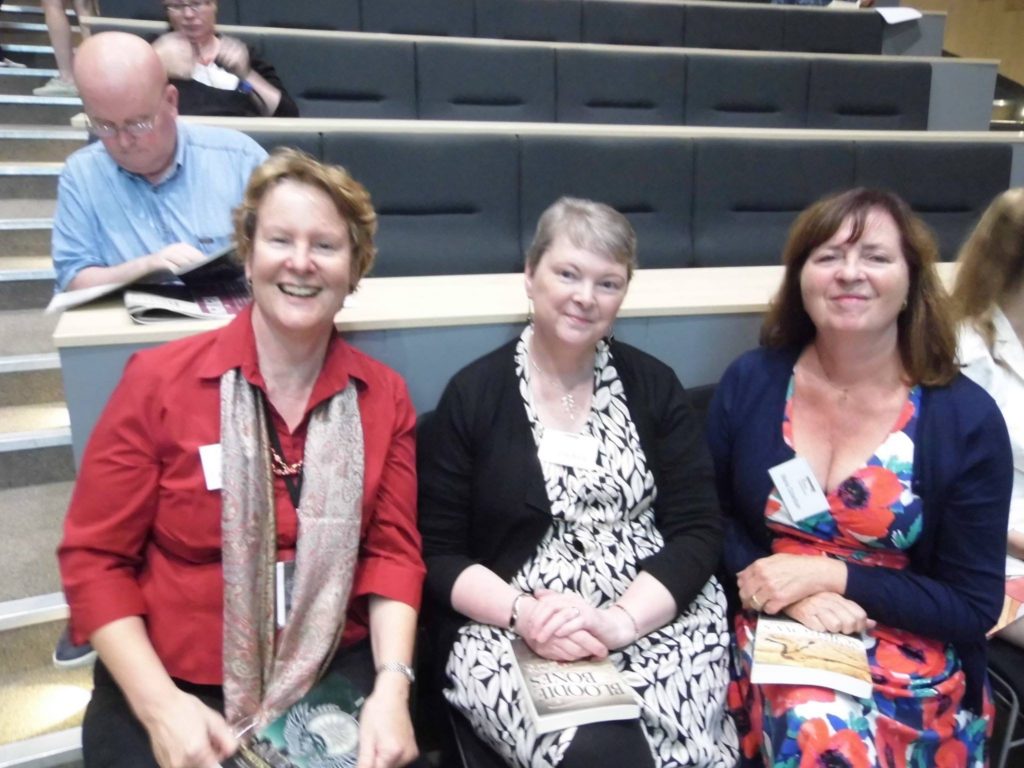 With Lucienne Boyce and Maria Dziedzan. All finalists in the 2016 HNS Indie Award, waiting for the announcement… There will be more…
Alison Morton is the author of Roma Nova thrillers, INCEPTIO, PERFIDITAS, SUCCESSIO and AURELIA. The fifth in the series, INSURRECTIO, was published in April 2016.
Find out more about Roma Nova, its origins, stories and heroines…
If you enjoyed this post, do share it with your friends!Like this:Like Loading...
You’ve seen the most wonderful picture on Google Images. An online blog has the perfect photo for your book cover. Look at that graphic – wouldn’t that make your book event notice/header/PR banner shine?
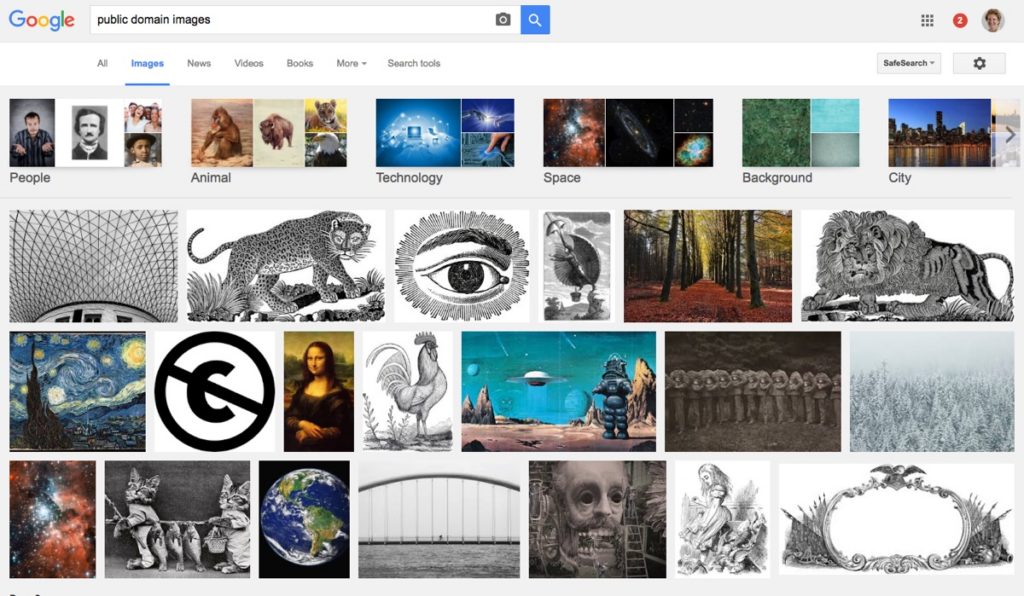
STOP!
Unless you pay a licence or ask the owner’s permission to reproduce it, it’s theft. The least you could expect is a reprimand and a demand to cease using it; you could also receive a huge bill or be prosecuted in court. Just because it’s online doesn’t mean you can use it. Only public domain and wide licences like Wikipedia’s Creative Commons Licence or Gnu can be safe; even then you may need to acknowledge the image originator or accept other conditions.
Copyright exists to protect the interests and income of the creator of an artistic work. I slog away on my 100,000 word novels for nearly a year. Average UK annual income for authors is £11,000* (Yes, it’s that low!). Even so, somebody pinching or pirating my work would represent a significant loss for me.
A photographer or artist takes time and expense to set up or compose an image/video/graphic and then sell it, whether freelance or on commission. This extends to websites, brands, book covers, adverts. This is their livelihood.
 So if an artist, writer, filmmaker, etc. creates an original product, it’s their copyright and they own the right to sell it or distribute it on their own terms. As soon as you write your short story, poem or novel, it’s automatically copyrighted to you. European authorities, thanks to EU harmonisation, take more or less the same strict attitude about protecting the creator’s ‘droits d’auteur’. So if an artist, writer, filmmaker, etc. creates an original product, it’s their copyright and they own the right to sell it or distribute it on their own terms. As soon as you write your short story, poem or novel, it’s automatically copyrighted to you. European authorities, thanks to EU harmonisation, take more or less the same strict attitude about protecting the creator’s ‘droits d’auteur’.
Some creatives handle the licensing of their own work, some use an agency and some distribute for free, but however published, the work’s copyright remains with the creator. A writer may give an agency exclusive representation authority to sell the rights to their work to a foreign publisher, or audio producer/retailer, but the copyright remains with the original author.
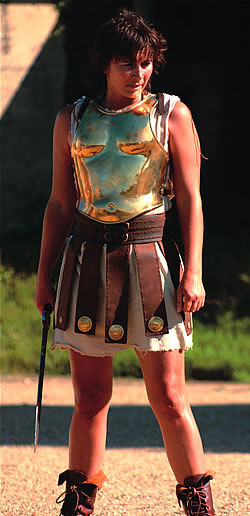 Photo courtesy of Britannia www.durolitum.co.uk Switching round, I buy images from image libraries, e.g. iStockphoto, but it’s only a licence to use and the licence can have restrictions such as ‘editorial use only’ which means you can only use the image in a news media or blog post, but not in PR material or cover of a book. Always best to read the licence agreement! Sometimes I download from a free library; no fee and I (usually) have permission to use the image as I wish, but the image is not mine. It’s still a form of licence.
Sometimes you can contact a photo owner and ask permission to use their image, but you should always annotate it “Courtesy of XXX” or “With kind permission of YYY”. This is why you see the caption you do under the picture of the gladiatrix which I use now and again. The copyright remains with Durolitum as they took the photo at one of their events. The benefit for them is that more people become aware of them.
Even if a friend says, “Sure, lift it from my Facebook page”, it’s best to acknowledge it. And in reverse, if you let somebody use an image you originated, e.g. a photo, you should stipulate that they should credit you – with a link to your website or wherever you originally posted it.
One of the safest ways is to take your own photos or use images that are over 150 years old and in the public domain. I love using old paintings such as this one for the first book trailer for INSURRECTIO.
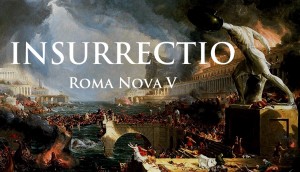
This is called Destruction from a series of four called The Course of Empire by Thomas Cole and dated 1836. It was perfect for the theme of the book. Later, in a redesign of the whole Roma Nova series, I swapped it for a much more sinister image with Caius Tellus projecting a seductive appearance that hides corruption. (Licence bought and paid for.)

In a connected topic, do remember that anything you post on social media is open book. Once posted, and whatever your privacy settings or legal niceties, your photos are public and you can’t stop anybody taking a copy. So post low resolution versions which, if anybody lifts them, won’t be good enough for printing or PR purposes.
Happy writing and stay legal!
* Source: Society of Authors
UPDATED 2021: Alison Morton is the author of Roma Nova thrillers – INCEPTIO, CARINA (novella), PERFIDITAS, SUCCESSIO, AURELIA, NEXUS (novella), INSURRECTIO and RETALIO, and ROMA NOVA EXTRA, a collection of short stories. Audiobooks are available for four of the series.Double Identity, a contemporary conspiracy, starts a new series of thrillers. Double Pursuit, the sequel, is now out!
Find out more about Roma Nova, its origins, stories and heroines and taste world the latest contemporary thriller Double Identity… Download ‘Welcome to Alison Morton’s Thriller Worlds’, a FREE eBook, as a thank you gift when you sign up to Alison’s monthly email newsletter. You’ll also be among the first to know about news and book progress before everybody else, and take part in giveaways.
If you enjoyed this post, do share it with your friends!Like this:Like Loading...
|
Subscribe to Blog via Email
Join 50 other subscribers.
Categories
Archive
|
 Today is the start of a new, possibly disruptive series, ‘Love me, love my character’. I’m inviting authors and their characters to give us their separate views. Hopefully, we may get some unexpected results.
Today is the start of a new, possibly disruptive series, ‘Love me, love my character’. I’m inviting authors and their characters to give us their separate views. Hopefully, we may get some unexpected results. Can secrets destroy love?
Can secrets destroy love?


































